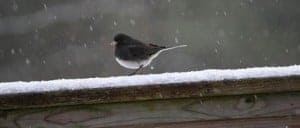
Now that leaves are falling, everyone seems to be talking about all things Autumn. Many would be surprised to know that for us at PIBO, “Fall” started August 1st! That’s when our Fall migration monitoring season officially began, as we started up the daily census once again. Since then, we’ve begun our daily banding operation in Fish Point Provincial Nature Reserve, and Fall 2013 monitoring is well underway.If you keep up with our Migration Summaries, which are posted every 10-14 days, or follow our Facebook and Twitter pages, you’ll know that so far, it’s been pretty quiet. We are now starting to see greater numbers and a greater variety of birds, with more warblers coming through, and of course thrushes. Beginning in late October, we’ll do some owling in the evenings, and we’re looking forward to once again holding our public owling nights, giving owl banding demonstrations for friends, neighbours, and visitors on Pelee Island.
We always love having visitors to our migration monitoring station in Fish Point, but if you can’t make it out to visit us this season, here are some Fall and Winter back yard birding tips:
1) Provide plenty of food and water
Whether a bird is migrating or spending the winter in your area, they will require extra energy this time of year. Replenish water often, and make sure the waterer is cleaned out regularly to prevent algal growth, or the spread of disease. The best way to attract a variety of birds to your yard is to provide a variety of food sources.
Don’t forget, your garden is an excellent food source! Instead of dead-heading your spent flowers such as Coneflowers or Black-eyed Susans, consider leaving them instead for the birds to snack on – finches especially love to eat the seeds of these flowers. You can also purchase niger seed to attract House Finches, Purple Finches, and American Goldfinches to your yard. Cardinals and Blue Jays like black oil sunflower seeds and peanuts. To attract hummingbirds, you of course need to provide a source of nectar, by either hanging a hummingbird feeder, or planting their favourite flowers in your garden. Once the migrants have gone south, you can keep feeders out for finches, chickadees, woodpeckers, and nuthatches, all of whom will keep visiting you throughout the winter.
When choosing a birdfeeder, keep in mind the type of bird you want to attract, and whether they will be able to perch comfortably on the feeder. Lastly, keep birds safe while visiting your feeders by keeping your pet cat indoors. You can also protect birds from stray cats by placing feeders far away from any bushes or other spots that would allow cats to hide and wait for a chance to pounce. Cats kill up to 3.7 billion birds in a single year in the United States alone, so preventing these kills can have a large positive impact on bird populations.
2) Prevent birds from colliding with windows
Each year in North America, it is estimated that anywhere from 100 million to 1 billion birds are killed from collisions with buildings. During the day, this happens because birds cannot see glass; they simply see a reflection of the surrounding environment, and end up colliding with the glass head-on. In addition, many birds migrate at night, and use the stars to navigate. As a result, bright lights such as those from the windows of high-rise buildings will attract and confuse birds, resulting in more collisions. While high-rise buildings are the main collision threat, birds can also hit the windows of your home. Consider these tips from Project FLAP for reducing residential bird-window collisions.
3) Enjoy, and learn!
By now you’ve provided a safe and attractive habitat for birds in your backyard, with plenty of food and water, and collision and predator prevention measures in place. Now is the time to sit back and enjoy the avian visitors to your yard! Observing birds at feeders is a good way to begin identifying birds. Be sure to use resources such as a field guide to the birds of your region, or websites like the Cornell Lab of Ornithology site. If you think you see a rare species, or a species at risk, try to get a clear picture of it, and as many details as possible, and submit that information to a local bird, wildlife or nature organization (such as PIBO) who will pass the information on to the proper governmental or non-governmental organizations. If you find that you enjoy watching your feeder on a regular basis, consider participating in Project FeederWatch to help scientists study winter bird populations, and even joining a Christmas Bird Count in your area. You may also be interested in helping with the Birds and Windows project at the University of Alberta, to track the number of birds killed by window collisions. The data collected from all of these ‘citizen science’ projects are extremely important for bird conservation.
